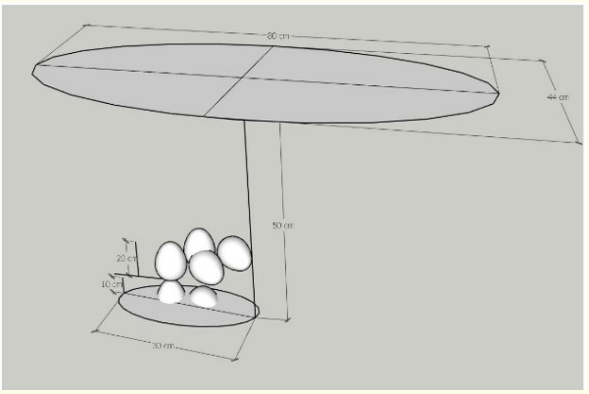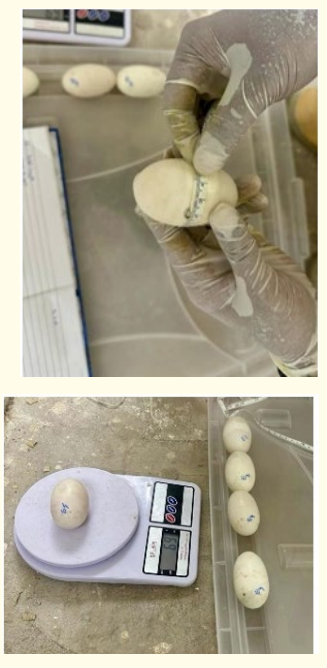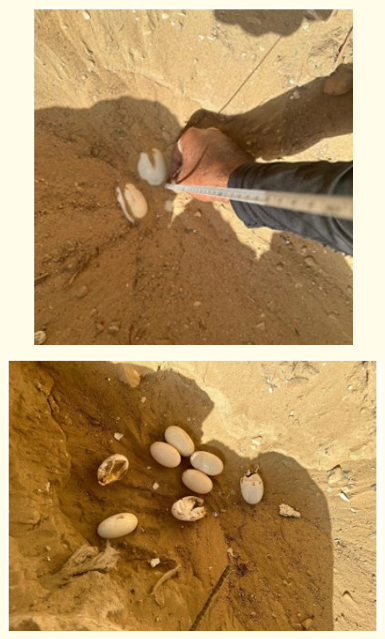SJ Jimmy Awany* and MD Angelo Kadahettige
Emirates Park Zoo and Resort, Abu Dhabi, UAE
*Corresponding Author: SJ Jimmy Awany, Emirates Park Zoo and Resort, Abu Dhabi, UAE.
Received: August 27, 2024; Published: September 16, 2024
Citation: SJ Jimmy Awany and MD Angelo Kadahettige. “Natural Breeding of Nile Crocodiles (Crocodylus niloticus) at Emirates Park Zoo and Resort”. Acta Scientific Veterinary Sciences 6.10 (2024): 13-16.
The study of Nile crocodiles’ natural nesting habits at Emirates Park Zoo and Resort focuses on key aspects such as nest construction, egg measurement, hatching outcomes, and maternal behavior. Out of the 16 observed eggs, there were 10 successful hatchings, resulting in a hatching success rate of 62.5%. Examining the environmental factors influencing the breeding process has yielded valuable insights for improving the Nile crocodile captive breeding program [1-4].
Keywords: Nile Crocodile; Breeding
The Nile Crocodile (Crocodylus Niloticus) is well-known for its sophisticated reproductive habits, which include nest construction and protective maternal care [1,2]. This study examines these behaviors in the uncontrolled habitat (Enclosure) of Emirates Park Zoo and Resort, with the objective of improving knowledge and breeding efforts for Nile crocodiles in captivity.
The nest measured 44 cm wide, 80 cm in length and 50 cm deep. The clutch of eggs that hatched was located 40 cm below the surface, while the unhatched eggs were found at a depth of 50 cm, resulting in a 10 cm difference between the hatched and unhatched clutches.
The total nest depth was 50 cm and to reach the eggs at the 20 cm of sand excavated to remove the hatchling by the female.

Figure 1: Showing nest construction.
Nest construction was monitored from April 19 to April 22, 2024. Egg laying and covering was not directly witnessed however, by April 23/2024 it was observed covered. Subsequently after 82 days we noticed heighten aggression by the family and spending more time near the nest, on the 97th day the hatching occurred and the mother’s hostile behavior continued for more eight days of post hatching (8 days) [2,4]. And the total period of aggression was 23 days from 14 July to 5th of August 2024.
ata Collection: All 16 eggs were measured to determine their circumference, length, width, height, and weight. The dimensions of five unhatched eggs were as follows

Figure 2: Measuring of the unhatched eggs and weighing of the unhatched eggs.
A total of ten hatchlings emerged successfully, with six remaining unhatched. The unhatched eggs were studied for possible causes of hatching failures [1,2].

Figure 3: Depth between the surface and six unhatched eggs in bottom eggs.
Hatchling measurements were recorded 17 days after hatching on August 15, 2024, while both parents were safely confined in the holding. The hatchlings were marked for identification, and the subsequent metrics were recorded.
The precise measurements of every hatchling offer an in-depth account of the hatchlings’ physical development during the early post-hatch period [5,6].
The nest provided a stable environment for egg incubation. The hatch success rate was 62.5%, with 10 of the 16 eggs hatching successfully. Slight variations in egg dimensions were recorded, typically for natural breeding. The 37.5% of unhatched eggs suggest possible issues related to incubation conditions, egg angle to support each other, and other environmental factors [2,4,6].
The Nile crocodile enclosure at Emirates Park Zoo and Resort is an open enclosure with a shaded area beneath an overhead feeding flat. The average temperature in the shaded nesting area was at 30-35 degrees, and the open full spectrum with light exposure averaged 35-46 degrees.
The first hatchlings hatched on July 28th, 2024. On the day of hatching, the mother was observed digging the sand off the nest (off the egg), which was interred at a depth of 50 cm, and the egg clutches filling the space 30 centimeters beneath 50 cm. She removed the hatching eggs with her mouth and transferred hatchlings to the pools of water [1,5].
Between July 29 and August 14, 2024, the following hatchling fatalities were documented as deaths:
As of August 15th, 2024, seven hatchlings were still alive. Fifteen days (from 14 July to 28th July 2024) before hatching, the mother exhibited growing aggression, actively guarding the nest and reacting violently to threats. Following hatching, she continued being aggressive for 8 days (29th July 2024 to 5th august 2024) were spent charging at everyone approaching the viewpoint [1,2,6].
Where the mother was overprotective, neither parent fed the hatchling, and the care staff designed the meal that included 100 grams of mince chicken and offered it to the hatchling. One of the feeding methods involved placing minced feed at the pool shore while the parents remained around. In certain instances, parents were first fed by providing them boneless diet down a rope which they snatched and swallowed. Two care staff fed two mature crocodiles concurrently. Ropes supplied feed from the feeding flat above the crocodile cage, reducing human care staff direct contact and ensuring safety and easy access to food by the hatchlings after their parents were full.
On August 4, 2024, 100g of minced chicken was offered to the hatchlings, and two of them responded and were observed feeding.
On August 6, 2024, another 100g of minced chicken was served, and three hatchlings responded and ate the meal.
August 8, 2024, three hatchlings started to feed on the 100 gram of mince chicken provided.
August 10, 2024, another 100g were given to the hatchlings, with only 02 observed feeding.
August 12, 2024, we continued to provide 100 g mince chicken. 05 hatchlings responded and swallowed the mince chicken offered.
On the 14th, neither of the seven hatchlings fed [2-4]. To guarantee that all of the hatchlings were fed, food was given out on various dates and with brief intervals. Mince chickens was placed on the pool’s shore, were the hatchlings like staying in pool.
The findings of the investigation provide an in-depth account of how Nile crocodiles procreate in an uncontrolled environment. The data about the young and feeding offers significant context for understanding the species’ early life stages.
The circumstances surrounding them might be responsible for the young’ varied consuming response. Nesting measurements and surroundings that are favorable to effective breeding were identified, showing the significance for nesting building and maternal attention. Temperature: 30-35 degrees Celsius; humidity: 40-80%. Additional research is required into the 37.5% of unhatched eggs, especially with reference to how the eggs need to be positioned within the nest [1,2,5].
The size variation between the hatched and unhatched eggs. could indicate a relationship between the measurements of the egg and the likelihood of successful hatching according to the data on eggs. The five eggs at the bottom in the clutch did not hatch despite developing into embryos, indicating that nest placement may have an impact on the hatchling’s outcome. The eggs at the highest of the clutch in the nest hatched successfully and on the other hand, the bottom did not. Twenty-three days of mother aggressiveness highlight how important protective behaviors are to the hatchlings’ survival.
This research of Nile crocodile’ natural breeding behaviors within captivity stresses the significance of choosing nest sites wisely, providing good care for mothers, and maintaining a watch upon environmental variables such habitat arrangement which promote natural behavior in the species. Future research need to focus on understanding reasons for the egg stage failures and improving Nile crocodile breeding environments [3,4,6].
Egg positioning: the discovery of eggs positioned towards the top and in the middle of the nest successfully hatched, whereas ones placed toward the bottom did not, reinforces the importance of properly planned enclosures to support natural reproduction as well as incubating resulting to successful hatching of eggs [2,4]. In accordance with the findings, female aggression serves a key part in protecting a nest and the young, that may substantially improve the chances of surviving within a natural breeding environment [5,6].
Copyright: © 2024 SJ Jimmy Awany and MD Angelo Kadahettige. This is an open-access article distributed under the terms of the Creative Commons Attribution License, which permits unrestricted use, distribution, and reproduction in any medium, provided the original author and source are credited.